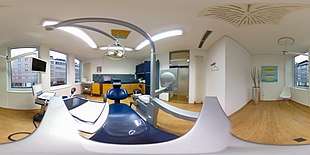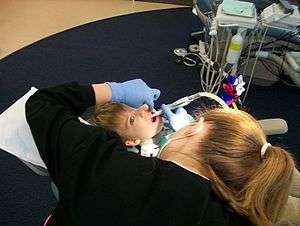Dentist
A dentist, also known as a dental surgeon, is a surgeon who specializes in dentistry, the diagnosis, prevention, and treatment of diseases and conditions of the oral cavity. The dentist's supporting team aids in providing oral health services. The dental team includes dental assistants, dental hygienists, dental technicians, and sometimes dental therapists.
 A dentist (seated) treating a patient with the help of an assistant (standing). | |
| Description | |
|---|---|
| Competencies | Biomedical knowledge, surgical dexterity, critical thinking, analytical skills, professionalism, management skills, and communication |
Education required |
|
History
Middle Ages
In China as well as France, the first people to perform dentistry were barbers. They have been categorized into 2 distinct groups: guild of barbers and lay barbers. The first group, the Guild of Barbers, was created to distinguish more educated and qualified dental surgeons from lay barbers. Guild barbers were trained to do complex surgeries. The second group, the lay barbers, were qualified to perform regular hygienic services such as shaving and tooth extraction as well as basic surgery. However, in 1400 France made decrees prohibiting lay barbers from practicing all types of surgery. In Germany as well as France from 1530 to 1575 publications completely devoted to dentistry were being published. Ambrose Pare, often known as the Father of Surgery, published his own work about the proper maintenance and treatment of teeth. Ambrose Pare was a French barber surgeon who performed dental care for multiple French monarchs. He is often credited with having raised the status of barber surgeons.[1][2]
Modern dentistry

show as 360° surround photography
Pierre Fauchard of France is often referred to as the "father of modern dentistry" for being the first to publish a scientific textbook (1728) on the techniques and practices of dentistry.[3] Over time, trained dentists immigrated from Europe to the Americas to practice dentistry, and by 1760, America had its own native born practicing dentists. Newspapers were used at the time to advertise and promote dental services. In America from 1768–1770 the first application of dentistry to verify forensic cases was being pioneered; this was called forensic dentistry. With the rise of dentists there was also the rise of new methods to improve the quality of dentistry. These new methods included the spinning wheel to rotate a drill and chairs made specifically for dental patients.[4]
In the 1840s the world's first dental school and national dental organization were established. Along with the first dental school came the establishment of the Doctor of Dental Surgery degree, often referred to as a DDS degree. In response to the rise in new dentists as well as dentistry techniques, the first dental practice act was established to regulate dentistry. In the United States, the First Dental Practice Act required dentists to pass each specific states medical board exam in order to practice dentistry in that particular state. However, because the dental act was rarely enforced, some dentists did not obey the act. From 1846–1855 new dental techniques were being invented such as the use of ester anesthesia for surgery, and the cohesive gold foil method which enabled gold to be applied to a cavity. The American Dental Association was established in 1859 after a meeting with 26 dentists. Around 1867, the first university associated dental school was established, Harvard Dental School. Lucy Hobbs Taylor was the first woman to earn a dental degree. In the 1880s, tube toothpaste was created which replaced the original forms of powder or liquid toothpaste. New dental boards, such as the National Association of Dental Examiners, were created to establish standards and uniformity among dentists.[4] In 1887 the first dental laboratory was established; dental laboratories are used to create dentures and crowns that are specific to each patient.[5] In 1895 the dental X-ray was discovered by a German physicist, Wilhelm Röntgen.[6]
In the 20th century new dental techniques and technology were invented such as: the porcelain crowns (1903), Novocain (a local anesthetic) 1905, precision cast fillings (1907), nylon toothbrushes (1938), water fluoridation (1945), fluoride toothpaste (1950), air driven dental tools (1957), lasers (1960), electric toothbrushes (1960), and home tooth bleaching kits (1989) were invented. Inventions such as the air driven dental tools ushered in a new high-speed dentistry.[4][4][7]
Responsibilities

By nature of their general training, a licensed dentist can carry out most dental treatments such as restorative (dental restorations, crowns, bridges), orthodontics (braces), prosthodontic (dentures, crown/bridge), endodontic (root canal) therapy, periodontal (gum) therapy, and oral surgery (extraction of teeth), as well as performing examinations, taking radiographs (x-rays) and diagnosis. Additionally, dentists can further engage in oral surgery procedures such as dental implant placement. Dentists can also prescribe medications such as antibiotics, fluorides, pain killers, local anesthetics, sedatives/hypnotics and any other medications that serve in the treatment of the various conditions that arise in the head and neck.
All DDS and DMD degree holders are legally qualified to perform a number of more complex procedures such as gingival grafts, bone grafting, sinus lifts, and implants, as well as a range of more invasive oral and maxillofacial surgery procedures, though many choose to pursue residencies or other post-doctoral education to augment their abilities. A few select procedures, such as the administration of General anesthesia, legally require postdoctoral training in the US. While many oral diseases are unique and self-limiting, poor conditions in the oral cavity can lead to poor general health and vice versa; notably, there is a significant link between periodontal and cardiovascular disease.[8] Conditions in the oral cavity may also be indicative of other systemic diseases such as osteoporosis, diabetes, AIDS, and various blood diseases, including malignancies and lymphoma.
Several studies have suggested that dentists and dental students are at high risk of burnout. During burnout, dentists experience exhaustion, alienate from work and perform less efficiently.[9] A systemic study identified risk factors associated with this condition such as practitioner's young age, personality type, gender, status of education, high job strain and / or working hours, and the burden of clinical degrees requisites. The authors of this study concluded that intervention programs at an early stage during the undergraduate level may provide practitioners with a good strategy to prepare for / cope with this condition.[10]
Regulations
Depending on the country, all dentists are required to register with their national or local health board, regulators and a professional indemnity insurance, in order to practice dentistry. In the UK, dentists are required to register with the General Dental Council. In Australia, it is the Dental Board of Australia, while in the United States, dentists are registered according to the individual state board. The main role of a dental regulator is to protect the public by ensuring only qualified dental practitioners are registered, handle any complaints or misconduct and develop national guidelines and standard for dental practitioners to follow. [11]
Specialties
Official specialties as recognized by the American Dental Association or the American Board of Dental Specialties[12]
- Anesthesiology [13]– The study and administration of general anesthesia, sedation and advanced methods of pain control
- Dental public health – The study of dental epidemiology and social health policies.
- Endodontics – Root canal therapy and study of diseases of the dental pulp.
- Oral and maxillofacial pathology – The study, diagnosis, and sometimes the treatment of oral and maxillofacial related diseases.
- Oral and maxillofacial radiology – The study and radiologic interpretation of oral and maxillofacial diseases.
- Oral and maxillofacial surgery – Extractions, implants, and MaxilloFacial surgery which also includes correction of congenital facial deformities.
- Oral Medicine[14]
- Orofacial Pain[14]
- Oral Implantology/Implant Dentistry[14]
- Orthodontics and dentofacial orthopaedics – The straightening of teeth and modification of midface and mandibular growth.
- Periodontology (periodontics) – Study and treatment of diseases of the gums (non-surgical and surgical) as well as placement and maintenance of dental implants
- Pediatric dentistry (formerly pedodontics) – Dentistry for children. Teeth, bones and jaw continually grow in children and certain dental issues in children require specific attention.
- Prosthodontics – Dentures, bridges and dental implants(restoring/placing). Some prosthodontists further their training in "oral and maxillofacial prosthodontics", which is the discipline concerned with the replacement of missing facial structures, such as ears, eyes, noses, etc.
Specialists in these fields are designated "registrable" (in the United States, "board eligible") and warrant exclusive titles such as dentist anesthesiologist, orthodontist, oral and maxillofacial surgeon, endodontist, pediatric dentist, periodontist, or prosthodontist upon satisfying certain local accreditation requirements (U.S., "Board Certified").
References
- "Ambroise Pare". Science Museum Brought to Life. Retrieved 5 May 2015.
- "History of Dentistry Timeline". American Dental Association. Retrieved 5 May 2015.
- "Pierre Fauchard: the 'Father of Modern Dentistry'". British Dental Journal.
- "History of Dentistry Timeline". American Dental Association.
- "Dental Laboratory Technology". American Dental Association.
- "Wilhelm Conrad Röntgen – Biographical". Nobelprize.org.
- "Dental Technology Over 150 Years: Evolution and Revolution". Journal of the Massachusetts Dental Society.
- "Gum Disease and Heart Disease - Perio.org". www.perio.org.
- pmhdev (2017-01-12). "Depression: What is burnout?". PubMed Health.
- Singh, P; Aulak, D. S; Mangat, S. S; Aulak, M. S (2016). "Systematic review: Factors contributing to burnout in dentistry". Occupational Medicine. 66 (1): 27–31. doi:10.1093/occmed/kqv119. PMID 26443193.
- "Dental Board of Australia - About". www.dentalboard.gov.au. Retrieved 2019-12-04.
- "Justia Law". US Court of Appeals, Fifth Circuit. 19 June 2017. Retrieved 17 January 2019.
- "Anesthesiology recognized as a dental specialty". www.ada.org. Retrieved 2019-03-13.
- "Member Boards | American Board of Dental Specialties". Retrieved 2019-03-13.